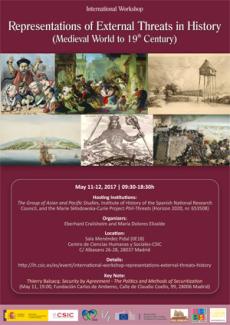International Workshop: "Representations of External Threats in History (Medieval World to 19th Century)"
Location: Sala Menéndez Pidal 0E18. Calle de Albasanz 26-28 (Madrid)
The Group of Asian and Pacific Studies, Institute of History of the Spanish National Research Council (CSIC), and the Marie Skłodowska‐Curie Project Phil‐Threats (Horizon 2020, nr. 653508) organize and invited researchers to present papers for the international workshop “Representations of External Threats in History (Medieval World to 19th Century)”, focusing on human threats.
Challenging our traditional understanding of external threats as parts of warfare and external politics, this workshop brings together papers which offer alternative ways to consider and analyse external threats by human agents. Instead of investigating movements of troops and diplomatic approaches, it takes a closer look at a specific set of questions: Who raised and maintained the issue as a threat and for whom (audience)? Which issues (threats) were chosen and why? What is the referent (threatened) object? Under what conditions did the representation of external threats take place and what are its results?
One of the basic effects of threat representation is the strengthening of the internal cohesion and of the existing order (G. Simmel, L.A. Coser). Consequently, the power of the governing class to release rights, duties, or obligations, is stronger in times of external threats than in times of peace. However, there has to be a certain level of acceptance that the threat is real, not only in democracies but also in colonial settings or other autocratic rules. Hence, threats have to be outlined and indicated as such.
Transmitting external threats is part of the academic field of political communication, which can be called “threat communication” (W. Schirmer). Relevant components are: sender, receiver (audience), the dynamic interplay between both, a reference object, a (real or imagined) threat, and a constructed collective (“the internal”) which contains all elements except for the outside threat (the “external”) against which all efforts are directed.
The idea of the workshop is influenced by investigations in the wake of the Copenhagen School of Securitization Studies and borrows concepts such as “Securitization” (when does an issue become a security problem?) and “Securitizing moves” (government attempts at transforming existing regimes of practices) (T. Balzacq et al., P. Bourdieux), which are adapted to historical processes and situations. However, it is not only discourses (e.g. chronicles, letters, reports, leaflets, books, laws, speeches, sermons, or all kinds of propaganda) that are in the centre of interest but also non-discursive practices, buildings, or objects (constituting a dispositive of threat).
Even though the workshop positions itself in the field of history, its features are interdisciplinary, crossing borders to cultural studies, anthropology, sociology, political science, security studies, and international relations. Concepts of the workshop include, but are by no means limited to securitization, fear, othering, enmification (demonizing people, religions, or ideologies), security cultures (if they exist and how do they look like), governmentality (based on M. Foucault) and threat communication. And of course, also the legal, social, or mental processes and changes are of interest, which are triggered by threat communication.
Hosting Institutions: The Group of Asian and Pacific Studies, Institute of History of the Spanish National Research Council, and the Marie Skłodowska-Curie Project Phil-Threats (Horizon 2020, nr. 653508)
Key Note: Thierry Balzacq: Conferencia: "Security by Agreement – The Politics and Methods of Securitization" (May 11, 19:00h., Lugar: Fundación Carlos de Amberes, Calle de Claudio Coello, 99, 28006 Madrid)
Contact: Eberhard Crailsheim eberhard.crailsheim [at] cchs.cisc.es




